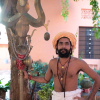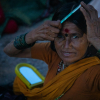Badagas are one of the indigenous tribal communities of the Nilgiri hills in southern India. They have their own language called Badaga (Badagu), and unique customs, rituals, traditions and culture. Among their main rituals are those relating to the wedding ceremony, which is comparatively simple and is conducted at the groom's place (unlike the practice in most other parts of India), and also the elaborate funeral rites. Since the funeral is a village (common) affair and conducted by all the villagers, the concerned family is relieved of much of the burden both financially and emotionally.
When a death occurs in a Badaga village, the information is given to the village headman, known as Gowda, and village managing committee, elected every year. They inform all the relatives and friends spread in and around the other villages (called hattis) and even relatives living far away. Arrangements are made for flowers and other essential ritual items. In earlier days, when communication through phones was nonexistent, men from the village would be sent to announce the death in person.
At the house where the death has taken place, the body is washed and dressed in new clothes. For a male, this would be a white veshti or mundu wrapped around the waist and a white shirt and white turban. For females, instead of a turban, a white cloth (pattu) is tied around the head. The body is placed on the ground and covered in a traditional white sheet with golden thread work called seeley (for the males), and a colourful cloth called banna for females. A traditional lamp, deepam, is lit and placed near the head. The mourning relatives sit around the body as the relatives and friends pour in to pay homage.
The next morning, the body is taken to the dhodda mane keri (courtyard of the 'big house', a sacred space) and placed on a cot (kattilu). This cot is decorated with cloth covering on the top and colourful umbrellas on the four sides and in the centre. Benches are placed on both sides where close relatives sit in mourning.
In a practice known as 'Saavu Muttuvadhu', those who come to pay homage either touch the feet of the deceased (if s/he is elderly or the head of the village), or if the person is younger, then the villagers render appropriate songs while waiting for the relatives to arrive. If the dead person is a female, the women from her parental village dance moving around the cot in a circle. Usually around 1:00 p.m. a pooja is performed at the foot of the cot after removing the benches. Accompanied by bhajans, people go around the village three times, at the end of which flower petals are showered on the corpse.
The cot with the body is now taken to the village grass and placed so that the feet are facing east. The poles tied to the cot along with the flowers and umbrellas are removed and the body is exposed to the sky. At this time, one of the most important funeral rituals called 'Karu Harachuvadhu' (chanting of funeral prayer) is performed. This prayer has significant importance attached to it. The transference of evils to a calf (a bull calf for males) is conveyed through this prayer and hence any Badaga who would have committed the (maximum of 1300) sins is relieved of them, so that her or his soul can reach the heavens with no sins attached to it. This prayer is chanted only by the men. An elderly gentleman at the head will mention the name of the person and explain how the life that had come from the womb would now leave this world for a 'maya' world. As he lists out the sins, the crowd around would chant the last word that ends in 'sin' (pappa). For example, one of the sins might be pulling out tender young green plants from the earth (the deeper meaning being molesting young girls), for which the prayer goes like this.
[The elder] Hachchaya kiththadhu pappa......[the crowdaround]...pappa
When this prayer is over, the formal declaration or transformation of the wife/husband to a widow/widower is carried out by removing the jewellery worn. After this, the immediate relatives, separated generation-wise into brothers, sons and grandsons perform the 'Akki Ethhovadhu'—placing grains on the mouth/face of the deceased. This is done in single file starting from the sacred Dhodda Mane and going around the cot three times in an anti-clockwise direction. The widow/widower is taken in an anti-clockwise direction.
Immediately after this ritual, the body is taken to the grave yard, called Dhoovay, where after prayers are said the departed soul is respectfully buried.
Online Resources
For more information and pictures, see https://badaga.co/badaga-funeral-rites/ and http://badaga-funeral.blogspot.in/ or https://badaga.co/2015/06/19/badaga-funeral-away-from-the-hatti/
The complete funeral prayer is given here: http://badaga-funeral.blogspot.in/ and in audio - https://soundcloud.com/bjaypee/sets/badaga-funeral-prayer












